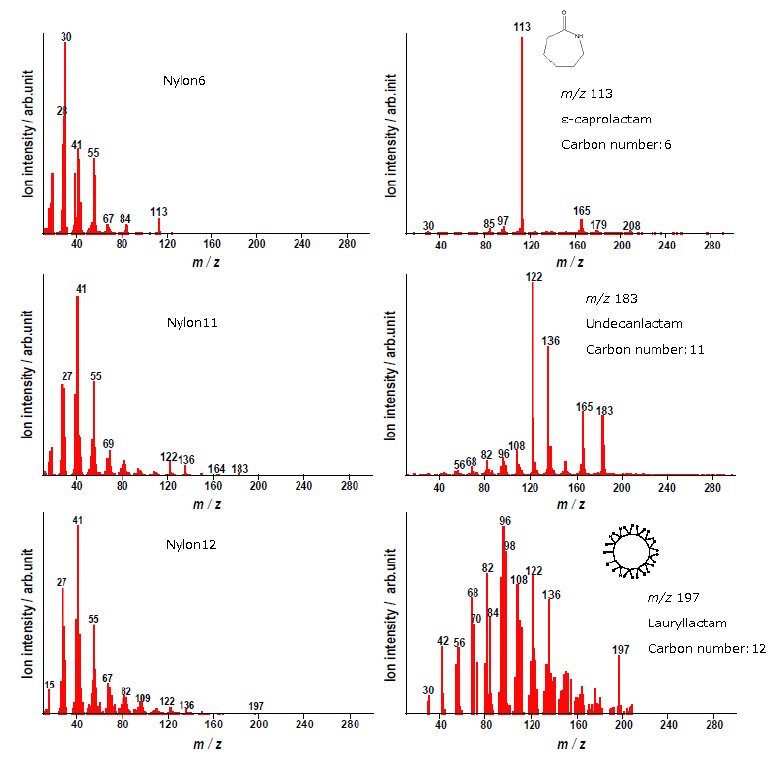Rapid Discrimination of Thermal Decomposition Analysis for Nylons
Introduction
The detection or analysis of the gases evolved during a chemical reaction, as a function of temperature, constitute the techniques of thermal analysis called evolved gas detection (EGD) and evolved gas analysis (EGA), respectively.
Thermal analysis using mass spectrometry covers a large number of related and analytical powerful techniques such as evolved gas analysis using mass spectrometry (EGA-MA) including thermogravimetry-mass spectrometry (TG-MS), temperature programmed pyrolysis-mass spectrometry and temperature programmed desorption mass spectrometry.
In conventional EGA-MS, the evolved gaseous products, which are introduced rapidly to MS, are generally ionized by electron ionization (EI) at 70 eV. In this case, a part of the evolved gaseous molecular ion undergoes further decomposition, and observed simultaneously ions. Especially in the thermal processes, since the evolved gases consists of multiple gaseous species in almost all cases, the resulting fragment ions are overlapped, while the fragment ions provide significant information concerning the structure of the molecule, the apparent mass spectra can be quite complicated. In order to differentiate in real-time the multiple organic species that are evolved in the thermal process, one feasible approach is the use of MS with a selective and soft (fragment-free) ionization technique which avoids fragmentation during ionization.
Nylon is a polyamide including multiple monomers combined by amide bonds. To study thermal decomposition of three typical nylon resins that have similar structures, we employed the skimmer-type TG-DTA-PIMS, photoionization mass spectrometer. It is possible to characterize the evolved gases in real time and to discriminate easily each nylon.
Instrument: ThermoMass Photo
ThermoMass Photo is an evolved gas analytical system designed for real-time simultaneous measurements of thermogravimetry – differential thermal analysis (TG-DTA) coupled with electron impact ionization (EI) and the fragment-free photoionization (PI) mass spectrometry (MS) that performs measurements as a function of temperature or time.
Measurement and analysis
Comparisons between the results from EIMS and PIMS for pyrolysate of three types of nylon obtained by EI/PIMS are shown in Figure 1. These nylons have similar chemical structures.
Because the observed EI mass spectra seem similar to each other, it is difficult to directly characterize them and to differentiate the individual nylons.
On the other hands, because the PI spectra are composed of only the molecular ions from the degradation products that originate from the polymer backbone structure, which are unique to each sample, the individual nylons can be definitively identified.
As monomers, Nylon 6, Nylon 11, and Nylon 12 are identified on mass spectrum for ε-caprolactam of m/z 113 (Carbon number: 6), undecane of m/z 183 (Carbon number: 11) and lauryl lactam of m/z 197 (Carbon number: 12) respectively.
Thus, as shown in this fingerprint analysis, the unique feature of PIMS allows easy differentiation of nylons, and it is useful to detect a minute change among the samples.

Figure 1: Comparison of mass spectra for nylons in inert atmosphere (Left:EI mass spectra; Right:PI mass spectra)

Contact Us
Whether you're interested in getting a quote, want a demo, need technical support, or simply have a question, we're here to help.
